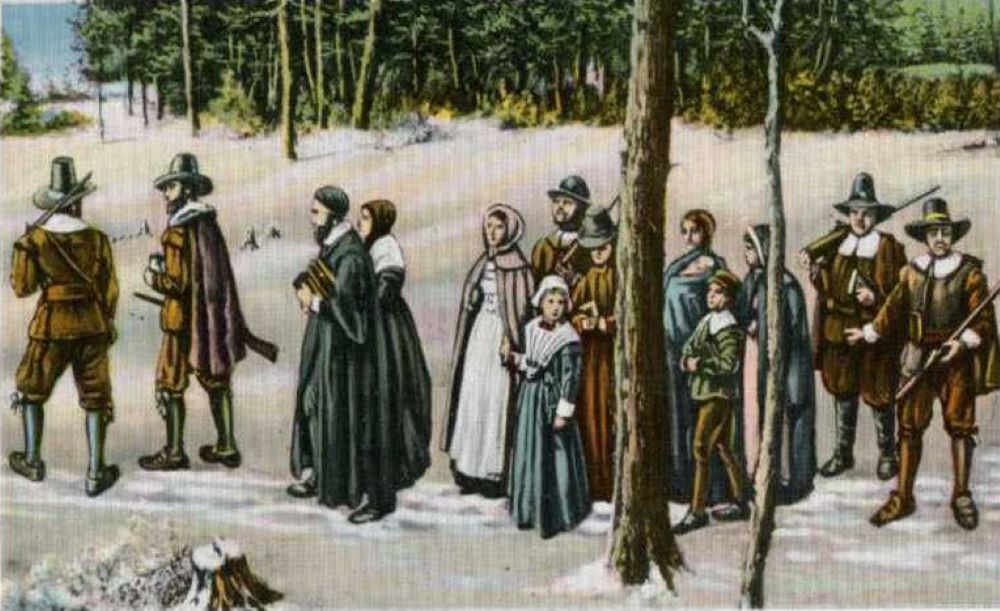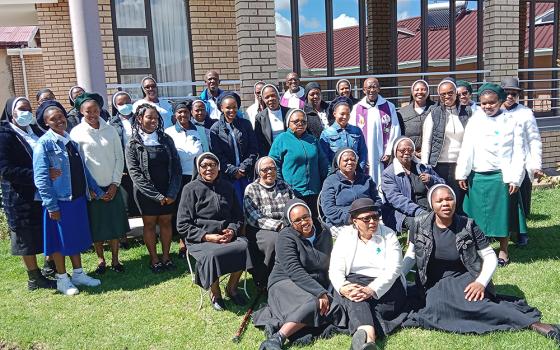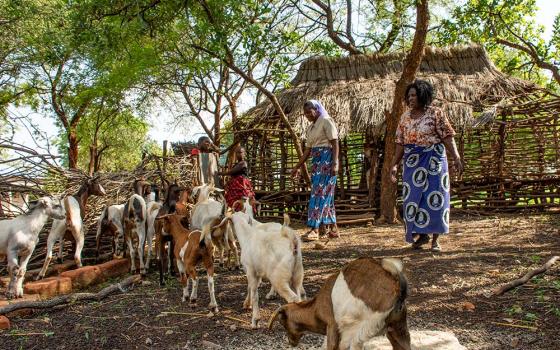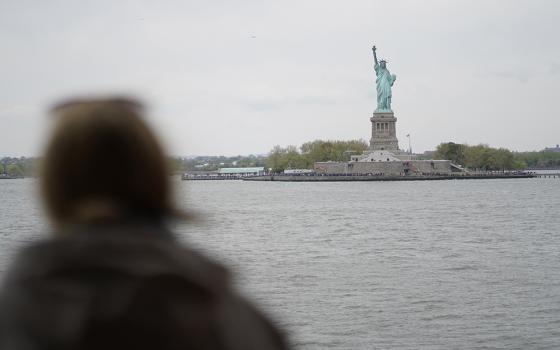
A postcard depicting the first Thanksgiving in November 1621, circa 1916 (Wikimedia Commons/Curt Teich Postcard Archives Digital Collection, Newberry Library)
Autumn in the Midwest is my favorite season. Leaves crunching beneath my feet and showering themselves everywhere. The first cool bite of winter is quickly replaced by a warm gentle breeze. Darkness creeps ever closer, making days much shorter. And I know the celebrations that I love — Thanksgiving, Advent and Christmas — will soon be here.
As I began to think about Thanksgiving, I went back to its beginnings. Googling it, I was reminded that it is a celebration of thanks for the blessings of the harvest and of the preceding year. It is a tradition shared by many countries. In the United States, its origins go back to a harvest feast shared in 1621 between the Pilgrims of Plymouth colony and the native Wampanoag people. It became a national holiday in 1863, during the Civil War. President Abraham Lincoln proclaimed Thanksgiving as a day of gratitude and reflection and as a means to promote unity among Americans.
Depending on who you are in the U.S. today, the harvest of the last year might look quite different as decisions and actions have benefited certain groups and hurt others. And, as during the Civil War, the country's unity is fractured.
Ironically, even as we prepare to celebrate the first immigrants who arrived on this soil feasting with the members of the native Wampanoag tribe, we are at great odds about how we view and discuss immigrants and immigration today.
Inviting us to a day of gratitude and reflection might seem impossible, but I'm wondering if that is what we need to do. I'm wondering if on this day we might pause and bring to our contemplation a remembrance of who we are and our own family history of coming to the United States.
Can we make this Thanksgiving a celebration of gratitude and a means to promote unity among all sectors of our nation as was the hope of the original holiday?
We each have a different story, and yet there is a common refrain. Whenever our ancestors arrived on the shores of this country, they came from somewhere else unless you have the privilege of having Native American blood in your ancestry. Probably they came because they were seeking a better life, fleeing an authoritarian regime, seeking economic security not only for themselves but for the family they left behind, and had hopes and dreams to fulfill. They were attracted to the values of freedom, opportunity, equality and hope that emanated from this nation. And our ancestors came at different times in our developing understanding of who we are as a nation and what it means to be part of the United States.
I remember quite clearly that whenever I asked my father what nationality we were, he would say, "We are American." I knew that there was something more than that because my friends were saying that they were Irish or German or Italian. It was clear that my father wanted my sister and me to grow up educated, speak English correctly, and become part of the culture of a post-World War II United States. All my questions about our past were met with "why do you want to know? … It's not important."
My grandparents came from Poland, prior to its independence in 1918, while it was still divided, beginning in 1795, among Austria, Prussia and Russia. In the wake of WWII, such a heritage was suspect. I only knew one grandparent, my father's mother, who spoke only Polish, but I was not taught to speak it. The history across the ocean was forgotten or never known by my parents. Even the family origins of where the family lived in Poland were dismissed since most of the records were destroyed in the war.
I was proud to be an American, as my father would say, but over time realized how meager my knowledge of my heritage was as others younger than I grew up at a time when learning one's ancestral language, the food, the customs, dances, and songs of one's heritage grew in importance.
That has continued to increase with the popularity of genealogy sites like ancestry.com.

(Pixabay/Sabrina_Ripke_Fotografie)
To be honest, I felt a bit jealous. Don't get me wrong, I was happy and proud to be so integrated into the U.S. culture, but I felt that it was truncated, that there was a horizon beyond the continental U.S. that was part of who I am but of which I would never know.
The next decades brought a significant change to how we would assimilate into the United States. Living in Chicago, like many urban areas, there were divisions along ethnic and racial lines creating different neighborhoods. If you were Catholic, it was typical to find three or four Catholic churches for different ethnic groups within blocks of each other. You went to the Irish, Polish, German, Italian, etc. church and never the others.
Drawing on a Catholic example, at that time it was rare to have a "mixed marriage" — which meant a Catholic and a Protestant were marrying. In the following decades, races mixed, religions mixed, sexes mixed and new expressions of what it means to be an American emerged. My godson married a woman from India, and their two beautiful little girls are growing up in the U.S. within two traditions: Catholicism, the Western world, and Hinduism, the Eastern world. This does not diminish who we are; it enriches it.
The United States is a country not bound by one race or one language or one religion. We are a society of individuals trying to embody values like fairness, decency, justice, belief in the dignity and rights of the other, participation, the rule of law, freedom of speech, and freedom of religion as we become one nation.
It is precisely that we have tried to live those values and embody them in the structures of our government throughout the decades that thousands of people wanted to come here and become part of our life. This continues today, brings its challenges, and is being threatened. We need to work to continue to have an identity as a country with such diversity. We need ways to communicate with one another, to share common values, to celebrate common rituals, and learn new ones. We need to trust one another.
My parents grew up at a time when assimilation into the United States meant absorbing the mores and culture of those in power, which were the white, Christian, "native-born" and English- speaking men. The early settlers, our first immigrants, tragically erased the truly native born, the many Indigenous tribes of Native Americans, failing to enter into their culture in bringing forth the creation of the new.
In the face of growing diversity within our nation, this "nativist belief" is being touted again by the radical right and some people in power politically. Many of them are younger than I am, and I can't stop wondering if they are missing the richness of what is theirs beyond the ocean or the border and that their response is also masking their jealousy and envy.
Of course, there are legitimate concerns about the speed and number of people wanting to come here and how to integrate the richness of who we are becoming so that there is an identity we share. But that cannot come by making those seeking to be part of us "our enemies," which only continues the polarization we are experiencing.
Advertisement
Can we make this Thanksgiving a celebration of gratitude and a means to promote unity among all sectors of our nation as was the hope of the original holiday?
Perhaps when you are gathered with family and friends for Thanksgiving dinner, you might reflect and celebrate the story of how your family got to the United States. What has your monolithic or diverse ancestry contributed to our culture? What have you learned and valued from being part of the U.S. culture? What hopes do you have for our future? What challenges do you see as we move into the future?
Then imagine that harvest feast of 1621 in Plymouth, Massachusetts, and keep expanding the picture of who you are seeing. Bring into focus the people with whom you work; who serve you at restaurants and fast food places; who care for you as doctors, dentists and other providers; who keep our cities, offices, houses and yards clean and safe. See their faces and think about where they came from and their ancestors' journey to the United States. How they have contributed to who we are. Make it as large as you can.
Then step back and have a happy Thanksgiving!






